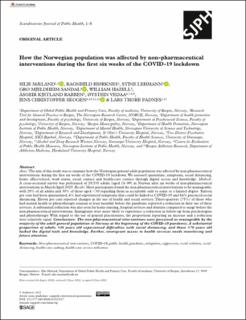| dc.contributor.author | Mæland, Silje | |
| dc.contributor.author | Bjørknes, Ragnhild | |
| dc.contributor.author | Lehmann, Stine | |
| dc.contributor.author | Sandal, Gro Mjeldheim | |
| dc.contributor.author | Hazell, William | |
| dc.contributor.author | Rabben, Åsgeir Kjetland | |
| dc.contributor.author | Vedaa, Øystein | |
| dc.contributor.author | Skogen, Jens Christoffer | |
| dc.contributor.author | Fadnes, Lars T. | |
| dc.date.accessioned | 2021-10-12T07:44:21Z | |
| dc.date.available | 2021-10-12T07:44:21Z | |
| dc.date.created | 2021-08-06T13:30:42Z | |
| dc.date.issued | 2021 | |
| dc.identifier.citation | Scandinavian Journal of Public Health. 2021, . | en_US |
| dc.identifier.issn | 1403-4948 | |
| dc.identifier.uri | https://hdl.handle.net/11250/2789142 | |
| dc.description.abstract | Aims
The aim of this study was to examine how the Norwegian general adult population was affected by non-pharmaceutical interventions during the first six weeks of the COVID-19 lockdown. We assessed quarantine, symptoms, social distancing, home office/school, work status, social contact and health-care contact through digital access and knowledge.
Methods
A cross-sectional survey was performed of 29,535 adults (aged 18–99) in Norway after six weeks of non-pharmaceutical interventions in March/April 2020.
Results
Most participants found the non-pharmaceutical interventions to be manageable, with 20% of all adults and 30% of those aged <30 regarding them as acceptable only to some or a limited degree. Sixteen per cent had been quarantined, 6% had experienced symptoms that could be linked to COVID-19 and 84% practiced social distancing. Eleven per cent reported changes in the use of health and social services. Three-quarters (75%) of those who had mental health or physiotherapy sessions at least monthly before the pandemic reported a reduction in their use of these services. A substantial reduction was also seen for home nursing, hospital services and dentists compared to usage before the non-pharmaceutical interventions. Immigrants were more likely to experience a reduction in follow-up from psychologists and physiotherapy. With regard to the use of general practitioners, the proportions reporting an increase and a reduction were relatively equal.
Conclusions
The non-pharmaceutical interventions were perceived as manageable by the majority of the adult general population in Norway at the beginning of the COVID-19 pandemic. A substantial proportion of adults <30 years old experienced difficulties with social distancing, and those >70 years old lacked the digital tools and knowledge. Further, immigrant access to health services needs monitoring and future attention. | en_US |
| dc.language.iso | eng | en_US |
| dc.publisher | Sage | en_US |
| dc.rights | Navngivelse 4.0 Internasjonal | * |
| dc.rights.uri | http://creativecommons.org/licenses/by/4.0/deed.no | * |
| dc.title | How the Norwegian population was affected by non-pharmaceutical interventions during the first six weeks of the COVID-19 lockdown | en_US |
| dc.type | Journal article | en_US |
| dc.type | Peer reviewed | en_US |
| dc.description.version | publishedVersion | en_US |
| dc.source.pagenumber | 0 | en_US |
| dc.source.journal | Scandinavian Journal of Public Health | en_US |
| dc.identifier.doi | 10.1177/14034948211027817 | |
| dc.identifier.cristin | 1924387 | |
| cristin.ispublished | true | |
| cristin.fulltext | original | |
| cristin.qualitycode | 1 | |

